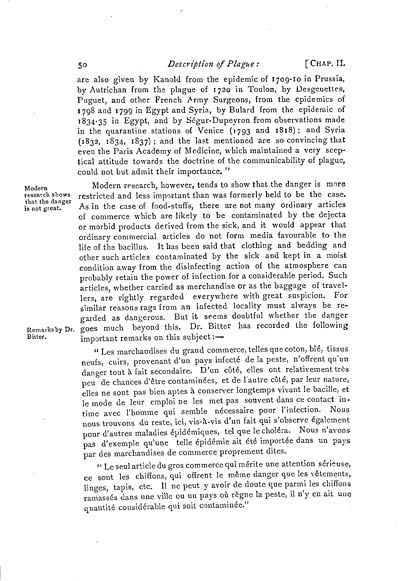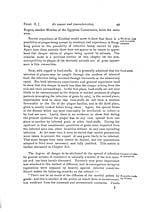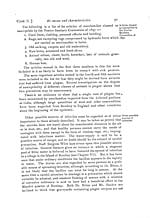Medicine - Disease > Plague in India, 1896, 1897 > Volume 1
(71) Page 50
Download files
Individual page:
Thumbnail gallery: Grid view | List view

50 Description of Plague: [CHAP. II.
are also given by Kanold from the epidemic of 1709-10 in Prussia,
by Autrichan from the plague of 1720 in Toulon, by Desgeuettes,
Puguet, and other French Army Surgeons, from the epidemics of
1798 and 1799 in Egypt and Syria, by Bulard from the epidemic of
1834.35 in Egypt, and by Sgur-Dupevron from observations made
in the quarantine stations of Venice (1793 and 1818); and Syria
(1832, 1834, 1837); and the last mentioned are so convincing that
even the Paris Academy of Medicine, which maintained a very scep-
tical attitude towards the doctrine of the communicability of plague,
could not but admit their importance."
Modern
research shows
that the danger
is not great.
Remarks by Dr.
Bitter.
Modern research, however, tends to show that the danger is more
restricted and less important than was formerly held to be the case.
As in the case of food-stuffs, there are not many ordinary articles
of commerce which are likely to be contaminated by the dejecta
or morbid products derived from the sick, and it would appear that
ordinary commercial articles do not form media favourable to the
lite of the bacillus. It has been said that clothing and bedding and
other such articles contaminated by the sick and kept in a moist
condition away from the disinfecting action of the atmosphere can
probably retain the power of infection for a considerable period. Such
articles, whether carried as merchandise or as the baggage of travel-
lers, are rightly regarded everywhere with great suspicion. For
similar reasons rags from an infected locality must always be re-
garded as dangerous. But it seems doubtful whether the danger
goes much beyond this. Dr. Bitter has recorded the following
important remarks on this subject:-
" Les marchandises du grand commerce, telles que coton, bl, tissus
neufs, cuirs, provenant d'un pays infect de la peste, n'offrent qu'un
danger tout fait secondaire. D'un ct, elles ont relativement trs
peu de chances d'tre contamines, et de l'autre ct, par leur nature,
elles ne sont pas bien aptes conserver longtemps vivant le bacille, et
le mode de leur emploi ne les met pas souvent dans ce contact in-
time avec l'homme qui semble ncessaire pour l'infection. Nous
nous trouvons du reste, ici, vis--vis d'un fait qui s'observe galement
pour d'autres maladies pidmiques, tel que le cholra. Nous n'avons
pas d'exemple qu'une telle pidmie ait t importe dans un pays
par des marchandises de commerce proprement dites.
" Le seul article du gros commerce qui mrite une attention srieuse,
ce sont les chiffons, qui offrent le mme danger que les vtements,
linges, tapis, etc. Il ne peut y avoir de doute que parmi les chiffons
ramasss dans une ville ou un pays o rgne la peste, il n'y en ait une
quantit considrable qui soit contamine."
are also given by Kanold from the epidemic of 1709-10 in Prussia,
by Autrichan from the plague of 1720 in Toulon, by Desgeuettes,
Puguet, and other French Army Surgeons, from the epidemics of
1798 and 1799 in Egypt and Syria, by Bulard from the epidemic of
1834.35 in Egypt, and by Sgur-Dupevron from observations made
in the quarantine stations of Venice (1793 and 1818); and Syria
(1832, 1834, 1837); and the last mentioned are so convincing that
even the Paris Academy of Medicine, which maintained a very scep-
tical attitude towards the doctrine of the communicability of plague,
could not but admit their importance."
Modern
research shows
that the danger
is not great.
Remarks by Dr.
Bitter.
Modern research, however, tends to show that the danger is more
restricted and less important than was formerly held to be the case.
As in the case of food-stuffs, there are not many ordinary articles
of commerce which are likely to be contaminated by the dejecta
or morbid products derived from the sick, and it would appear that
ordinary commercial articles do not form media favourable to the
lite of the bacillus. It has been said that clothing and bedding and
other such articles contaminated by the sick and kept in a moist
condition away from the disinfecting action of the atmosphere can
probably retain the power of infection for a considerable period. Such
articles, whether carried as merchandise or as the baggage of travel-
lers, are rightly regarded everywhere with great suspicion. For
similar reasons rags from an infected locality must always be re-
garded as dangerous. But it seems doubtful whether the danger
goes much beyond this. Dr. Bitter has recorded the following
important remarks on this subject:-
" Les marchandises du grand commerce, telles que coton, bl, tissus
neufs, cuirs, provenant d'un pays infect de la peste, n'offrent qu'un
danger tout fait secondaire. D'un ct, elles ont relativement trs
peu de chances d'tre contamines, et de l'autre ct, par leur nature,
elles ne sont pas bien aptes conserver longtemps vivant le bacille, et
le mode de leur emploi ne les met pas souvent dans ce contact in-
time avec l'homme qui semble ncessaire pour l'infection. Nous
nous trouvons du reste, ici, vis--vis d'un fait qui s'observe galement
pour d'autres maladies pidmiques, tel que le cholra. Nous n'avons
pas d'exemple qu'une telle pidmie ait t importe dans un pays
par des marchandises de commerce proprement dites.
" Le seul article du gros commerce qui mrite une attention srieuse,
ce sont les chiffons, qui offrent le mme danger que les vtements,
linges, tapis, etc. Il ne peut y avoir de doute que parmi les chiffons
ramasss dans une ville ou un pays o rgne la peste, il n'y en ait une
quantit considrable qui soit contamine."
Set display mode to: Large image | Zoom image | Transcription
Images and transcriptions on this page, including medium image downloads, may be used under the Creative Commons Attribution 4.0 International Licence unless otherwise stated. ![]()
| India Papers > Medicine - Disease > Plague in India, 1896, 1897 > Volume 1 > (71) Page 50 |
|---|
| Permanent URL | https://digital.nls.uk/74593834 |
|---|




